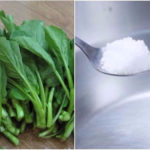Cooking Meat in Cold Water

If you want the meat to be tender, boil it in boiling water, but if you want the broth to be flavorful, boil it in cold water.
Usually, women often cook meat in cold water from the beginning. The usual method is to blanch the meat in boiling water and then rinse it again. After that, put the meat in a pot of cold water and boil it until cooked. But according to professional chefs, the best way to make the pork tender and flavorful is to cook the meat in boiling water.
According to the analysis of experts, with this cooking method, when the meat is not fully cooked (it may have been blanched and rinsed), putting it in boiling water will make the meat fibers and protein compounds firm and stick together, and the proteins inside will not be released.
Therefore, when cooking meat in boiling water, the meat will taste sweeter and more flavorful compared to when you put the meat in cold water and then cook it. This method will also preserve more nutrients (which are not destroyed by being boiled for too long).
If you want to use the cooking broth to make soup, you can cook it in the usual way, which is to boil it in cold water so that the sweetness from the meat can be released. However, with this method, you have to accept that the meat will not be as tasty as when it is cooked in boiling water.
Adding Cold Water while Cooking

Adding cold water while cooking will cause the meat to lose nutrients.
When cooking meat and the water is running low, the usual way most women handle it is by adding cold water to continue cooking. However, this action will ultimately make the meat less delicious.
When the meat is partially cooked at high temperatures, adding cold water will cause the proteins and fats in the meat and bones to immediately precipitate, making the meat shrink and become tough. This not only depletes the nutritional value of the meat but also affects its flavor.
Therefore, you need to estimate the right amount of cooking water from the beginning to avoid this situation.
Poking the Meat to Check
When you want to check if the meat is cooked or not, women often use a skewer to poke the meat. However, if you do this excessively, the sweet and savory flavors from the meat will seep out, resulting in the loss of flavor.
You need to accurately estimate the cooking time for the meat to be fully cooked. Depending on the thickness of the meat, the cooking time can range from 30 to 60 minutes.
You should also avoid overcooking the meat, as leaving the meat at a temperature of 200 – 300 degrees Celsius for a long time will cause amino acids, creatinine, sugar, and harmless compounds in the meat to undergo chemical reactions, forming aromatic amino acids.
You should only cook the meat until it is tender and regularly skim off any foam while cooking to ensure the meat is clean and fragrant.
A Method to Cook Tender and Delicious Pork Leg

Cleanly prepare pork legs and roll them tightly.
Ingredients: 8 ounces of pork leg; Seasonings: pepper, salt, fish sauce, seasoning powder; string for tying.
Instructions:
Step 1: Wash the pork leg with saltwater and drain it. Marinate half a teaspoon of pepper and 2 teaspoons of seasoning powder inside the pork leg.
Step 2: Use your hands to roll the pork leg tightly in the skin lengthwise like a sausage and tie it tightly from end to end.
Make sure the pork leg is tightly rolled so that the meat cubes stick together, forming a beautiful circle without breaking when cut.

Wait for the water to boil before placing the pork leg for cooking.
Step 3: Add 1 teaspoon of salt to the cooking water. When the water boils, add the pork leg. After boiling for 10 minutes, reduce the heat and let the pork leg cook thoroughly inside.
Depending on the size of the rolled meat, the boiling time is about 30-45 minutes (counting from the time when the heat is reduced).

Soak the cooked pork leg in iced water with a bit of salt.
Step 4: When the pork leg is cooked, turn off the heat. Soak the pork leg in a bowl of iced water with a bit of salt to make the meat white. Then, take it out and put it in the refrigerator for about 3 hours for the meat to become firm.

The cooked pork leg is beautifully cut into cubes.
When serving, remove the strings and cut the pork leg into pieces according to the shape. Serve with fish sauce and sliced chili and pickled cabbage.
According to Gia đình & Xã hội
Uncover the Surprising Health Advantages of Sugarcane Juice
Do you believe in the power of sugarcane juice? From giving your body an energizing natural boost to detoxifying your liver and aiding digestion, this drink offers an array of benefits. Not to mention its ability to help maintain healthy teeth, clear up skin, and combat fatigue. Have you ever wondered what wonders a simple glass of sugarcane juice can do for you?







































